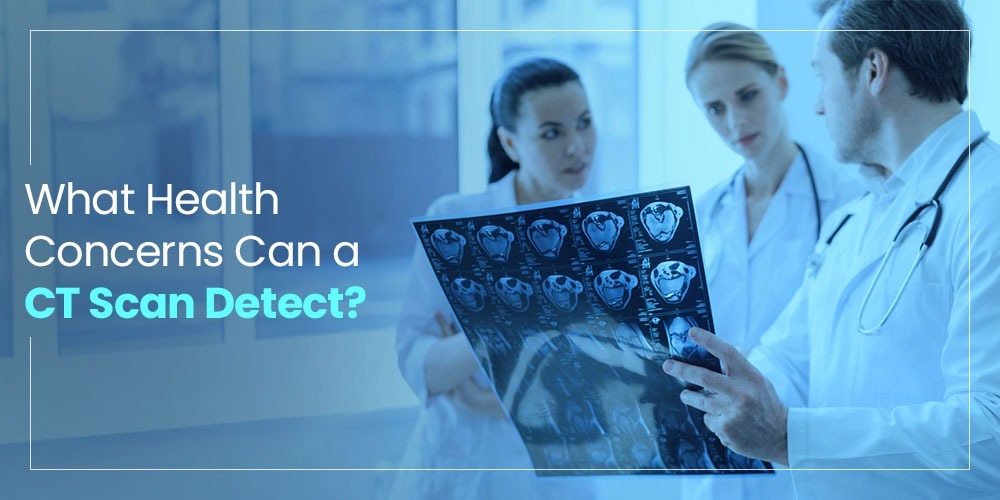A Computed Tomography (CT) or Computed Axial Tomography (CAT) scan is a medical imaging procedure, a radiological exam, used to capture two-dimensional pictures of the inside of a particular portion of the body. It involves the use of multiple X-rays to gather information and a computer to combine the data and generate highly detailed representations of the three-dimensional organs, bones, and other tissues within the body. A CT scan machine can be used to scan any part of the body taking a maximum of half an hour from start to finish and causing no pain or discomfort.
What health concerns can a CT scan detect?
Doctors may order a Computed Tomography scan for a variety of reasons. Here are the health concerns that a CT scan can detect which is why doctors order for a CT scan.
1. Blockages in the blood vessels or any other potential vascular problems
The images of blood vessels created by CT scans provide the required information to physicians for the diagnosis of vascular disease without having to perform surgical biopsies or invasive exploratory surgery. CT scans can help detect blockages or any other problems of the blood vessels.
2. Abdominal issues
CT abdominal scan uses barium or a contrast dye to produce intricate images of abdominal organs such as the kidneys, liver, spleen, gallbladder, uterus, and ovaries. The use of intravenous iodine-based dye during an abdominal CT scan provides refined images of the inside of the abdomen, allowing the physician to diagnose different abdominal issues. These include abdominal pain, an abnormal mass in the abdomen, unexplained weight loss, kidney stones, ureteral or bladder stones, and obstructions/inflammation in the small or large intestine.
3. Injuries of small bones
Any injury to small bones of the hands and feet may not be identifiable from X-rays alone. A Computed Tomography scan helps detect these injuries. The images created by a CT scan can be used as a guide by physicians to perform repair surgeries of the injured bones.
4. Tumors
A CT scan helps investigate tumors. It can provide information about the location and size of the tumor and how involved a tumor is with the nearby tissues. This information allows the surgeons to more efficiency perform biopsies and have better surgical outcomes.
5. Cancers
A CT scan can help diagnose cancer and form a treatment plan. It helps clarify the position of tumors and guides the surgeon in cancer treatment by determining the efficacy of chemotherapy and how much and how quickly cancer has spread.
6. Head and brain injuries or other issues
A head CT scan can provide images of the brain which can be used by physicians to evaluate bleeding, brain stroke, brain tumors, head injuries, persistent dizziness, and chronic or intense headaches.
Less commonly, a head Computed Tomography scan be used for planning surgical reconstruction; identifying inflammation in the sinuses; assessing aneurysms; evaluating bone and soft tissue damages after facial trauma; guiding the needle for brain biopsy; diagnosing issues with temporal bone in the skull that can result in hearing issues.
7. Soft tissue damages
X-ray alone reveals little information about soft tissue damage while a CT scan provides images of the conditions or damages of both soft tissues and bones. A CT scan can provide comprehensive information about injury or trauma on any body part and aid in diagnosis and recovery planning.
8. Spinal issues and chronic backache
A physician may order a spinal CT scan to detect spinal injury, diagnose scoliosis, evaluate congenital anomalies of the spine, evaluate spinal fractures, assess the spine condition before and after spinal surgery, diagnose the cause of backache, or measure the bone density to predict chances of fractures in people who are at high risk of osteoporosis.
9. Severe internal accidental injuries
A CT can help investigate a severe internal injury resulting from an accident. It is the first choice of imaging procedure when there is an emergency case of internal injury.
10. A condition or injury where MRI is inappropriate
MRI and CT scans are both medical imaging procedures. They are somewhat similar, but they may not be used for diagnosis in the same situations. In case of an injury or condition that prevents an individual from lying down for the time frame needed for an MRI scan, a CT scan is best as it produces a more accurate image in a shorter time. If an individual has a medical implant of any kind inside their body, MRI is not safe. Instead, a CT scan is recommended.
How does a CT scan work?
Computed Tomography scan produces a narrow X-ray beam that circles one section of the body and provides a series of images from different angles. A computer collects this information and uses it to create a cross-sectional picture. Just as a piece in a bread loaf, a CT scan shows a “slice” of the inside of the body. Repeated scanning of particular parts of the body results in several slices which computer stacks on top of one another to create detailed pictures of the organs, bones, blood vessels, or tissues.
Read our previous blog: How to Prepare for a CT Scan

